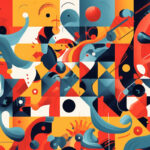If you’re a fantasy or science fiction enthusiast, then you know how important worldbuilding is in these genres. A well-crafted world immerses readers into the story and captivates their imagination, making them feel as though they are a part of that world. So, if you’re looking for inspiration for your own worldbuilding endeavors, you need to check out these books.

Understanding the Art of Worldbuilding
Worldbuilding is the craft of creating an imaginary world that is unique and believable. It involves creating everything from landscapes, cultures, languages, economies, politics, and more. Essentially, worldbuilding is painting a detailed picture of a fictional world where the story will be set.
When it comes to worldbuilding, the possibilities are endless. You can create a world that is similar to our own, with minor differences, or you can create a world that is completely different from anything that has ever existed. The key is to create a world that is believable and consistent.
What is Worldbuilding?
Worldbuilding is much more than merely setting the scene. Instead, it’s about creating a complete world that breathes life into the story and the characters that inhabit it. It’s about making the readers feel as though they are a part of that world, and everything about it is real.
One of the most important aspects of worldbuilding is creating a sense of history. This can be done by creating myths, legends, and historical events that have shaped the world. By doing this, you give your world depth and make it feel like it has a rich and complex history.
Another important aspect of worldbuilding is creating a sense of culture. This can be done by creating unique customs, traditions, and beliefs for the people who inhabit your world. By doing this, you make your world feel more alive and give your characters a sense of identity.
The Importance of Worldbuilding in Fiction
Worldbuilding is crucial in science fiction and fantasy genres because it creates a convincing and immersive universe. The story becomes more believable, and the characters more engaging and relatable. Successful worldbuilding allows readers to understand the mechanics of the world and adds depth to the themes in the story.
Worldbuilding can also be used to explore complex themes such as politics, religion, and social issues. By creating a world that is different from our own, you can explore these themes in a unique and interesting way.
Overall, worldbuilding is an essential part of any work of fiction. It allows you to create a world that is unique, believable, and engaging. By putting in the time and effort to create a rich and complex world, you can create a story that will captivate readers and leave them wanting more.
Classic Worldbuilding Books
Worldbuilding is a crucial element of science fiction and fantasy. It’s the process of creating a fictional world that is believable and immersive. Some of the best worldbuilding in science fiction and fantasy can be found in classic books. These authors paved the way for modern worldbuilding and set the standard for what readers expect.
J.R.R. Tolkien’s Middle-earth Series
Tolkien’s Middle-earth series is a perfect example of worldbuilding done right. From the different races such as Elves, Dwarves, and Hobbits to the intricate history and mythology, Tolkien creates a world that is rich and immersive.
The world of Middle-earth is so detailed that it feels like a real place. Tolkien’s attention to detail is evident in the different languages spoken by the characters and the maps he created to accompany the story. The Lord of the Rings, the story takes place in the heart of Middle-earth as Frodo and his companions embark on a journey to destroy the One Ring. The world is filled with danger, wonder, and magic, immersing the reader in the story and the world.
Tolkien’s influence on modern fantasy cannot be overstated. His worldbuilding has inspired countless authors and has become a standard for the genre.
Frank Herbert’s Dune Series
The Dune series is set in a universe filled with complex politics, religion, and ecology. From the Sandworms to the Spice, Herbert created a world that is unique and fascinating. The world of Dune is so well-crafted that the reader can get lost in it for hours on end.
The world of Dune is a harsh and unforgiving place, with a complex political system that is integral to the story. The planet of Arrakis, where the story takes place, is a desert world, and the people who live there have adapted to the harsh conditions. The world of Dune is a classic example of worldbuilding that still inspires authors today.
Herbert’s worldbuilding is so detailed that it has spawned an entire sub-genre of science fiction known as “ecological science fiction.”
Ursula K. Le Guin’s Earthsea Series
Le Guin’s Earthsea series is a world filled with magic, dragons, and wizards. The world is immersive and vivid, with a complex system of magic that is well thought out and integral to the story.
The world of Earthsea is a prime example of how worldbuilding can shape a story’s themes and character development. The story follows the wizard Ged as he navigates the complex world of magic and learns the true nature of power.
Le Guin’s worldbuilding is so well-crafted that it feels like a real place. The different islands in Earthsea each have their own unique culture and history, and the magic system is based on the balance of nature.
The Earthsea series has become a classic of the fantasy genre and has inspired countless authors to create their own unique worlds.
Modern Masterpieces of Worldbuilding
Modern-day authors have taken worldbuilding to new heights with intricate and complex worlds that are just as compelling as the classic ones. These worlds are rich with history, culture, and politics, making them feel like living, breathing places.
George R.R. Martin’s A Song of Ice and Fire Series
The world of Westeros in Martin’s A Song of Ice and Fire series is one of the most complex and detailed worlds in modern-day literature. Martin has created a world that is so vast and intricate that it feels like a real place. The world is filled with politics, intrigue, and conflict, with each character having their own motivations and goals. Martin’s worldbuilding has created a world that is fully realized and immersive.
One of the most impressive aspects of Martin’s worldbuilding is the attention to detail. The different regions of Westeros have their own unique cultures, languages, and social structures. The history of the world is rich and complex, with each event having far-reaching consequences. Martin’s worldbuilding is so well-crafted that it has spawned an entire fandom dedicated to exploring every detail of the world he has created.
N.K. Jemisin’s Broken Earth Trilogy
The world in Jemisin’s Broken Earth Trilogy is a post-apocalyptic world filled with dangerous earth-shaking powers. Jemisin’s worldbuilding is so well-crafted that it feels real, with unique cultures, languages, and social structures. The world is filled with magic and mystery, with a complex history that is slowly revealed throughout the series.
Jemisin’s worldbuilding adds layers of depth to her story, making it an immersive and captivating read. The world is so well-crafted that it feels like a character in its own right, with its own motivations and desires. The world is harsh and unforgiving, but it is also beautiful and awe-inspiring.
Brandon Sanderson’s Cosmere Universe
Sanderson’s Cosmere universe is a collection of different worlds, all connected by a central mythology. The worldbuilding is intricate and detailed, with magic systems that are unique to each world. The attention to detail is impressive, making Sanderson’s works a must-read for any worldbuilding enthusiast.
One of the most impressive aspects of Sanderson’s worldbuilding is the way he weaves together different worlds into a cohesive whole. Each world is unique, with its own cultures, histories, and magic systems. But they are all connected by a central mythology, creating a sense of unity and coherence throughout Sanderson’s works.
Sanderson’s worldbuilding is so well-crafted that it has spawned an entire community of fans dedicated to exploring every detail of the Cosmere universe. From the complex magic systems to the intricate histories of each world, Sanderson’s worldbuilding is a masterclass in the art of creating immersive and compelling fictional worlds.
Worldbuilding in Young Adult Fiction
Youthful readers love a well-crafted world and will become engrossed in a world just as deeply as any adult reader. These young adult books feature well-crafted worlds that readers of all ages can love.
J.K. Rowling’s Harry Potter Series
The world of Harry Potter is as enchanting as it is vast. Rowling creates a world that is both whimsical and mysterious, with its own unique system of magic. The magical creatures, spells, and potions make readers want to be a part of this world. Rowling’s worldbuilding brings Harry and his friends to life, making the story all the more plausible.
From the moment readers enter the Hogwarts School of Witchcraft and Wizardry, they are transported to a world that is both familiar and fantastical. Rowling’s intricate details, such as the moving staircases and the Forbidden Forest, make the world of Harry Potter feel real. The world is also filled with history, from the founding of Hogwarts to the tragic story of the Deathly Hallows. Each book in the series adds new layers to the world, making it one that readers can explore for years.
Philip Pullman’s His Dark Materials Trilogy
The world in Pullman’s His Dark Materials Trilogy is a parallel universe filled with magic and mystery. The world of daemons and the Alethiometer adds an extra layer of depth to the story, making it a must-read for anyone who loves intricately crafted worlds.
The world of His Dark Materials is one that is both familiar and strange. Pullman’s world is similar to our own, but with subtle differences that make it all the more intriguing. The concept of daemons, physical manifestations of a person’s soul, adds a new layer of depth to the characters. The Alethiometer, a device that can answer any question, adds mystery and intrigue to the story. The world is also filled with different factions, from the Gyptians to the witches, each with their own unique culture and beliefs.
Suzanne Collins’ The Hunger Games Trilogy
The world in the Hunger Games trilogy is one that is filled with danger, but it’s also one that is very familiar. Collins creates a dystopian world that is both exciting and horrifying. The world of the Hunger Games is one that is well-crafted and believable, making it a must-read for anyone who loves a good action-packed story.
The world of the Hunger Games is one that is both bleak and captivating. The Capitol is a place of excess and luxury, while the districts are filled with poverty and despair. The Hunger Games themselves are a brutal reminder of the Capitol’s power over the districts. Collins’ worldbuilding also includes the rebellion, which adds a new layer of depth to the story. The world is filled with different factions, each with their own motivations and beliefs, making it a complex and intriguing place to explore.
In Conclusion
In summary, worldbuilding is essential in creating a captivating story that immerses readers in an imaginary world. Whether it’s a classic or modern masterpiece, a well-crafted world adds depth to the story and makes the read more engaging. With these books, you’re sure to find inspiration for your own worldbuilding projects. Happy reading!
- The 11 Best Books About Cats You Should Read - January 16, 2024
- The 9 Best Books on Building Confidence - January 16, 2024
- Discover the 10 Best Books on the Brain - January 16, 2024





